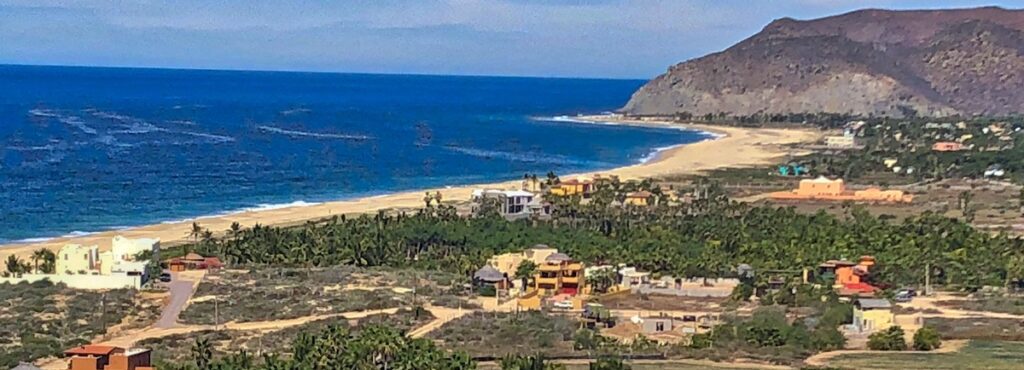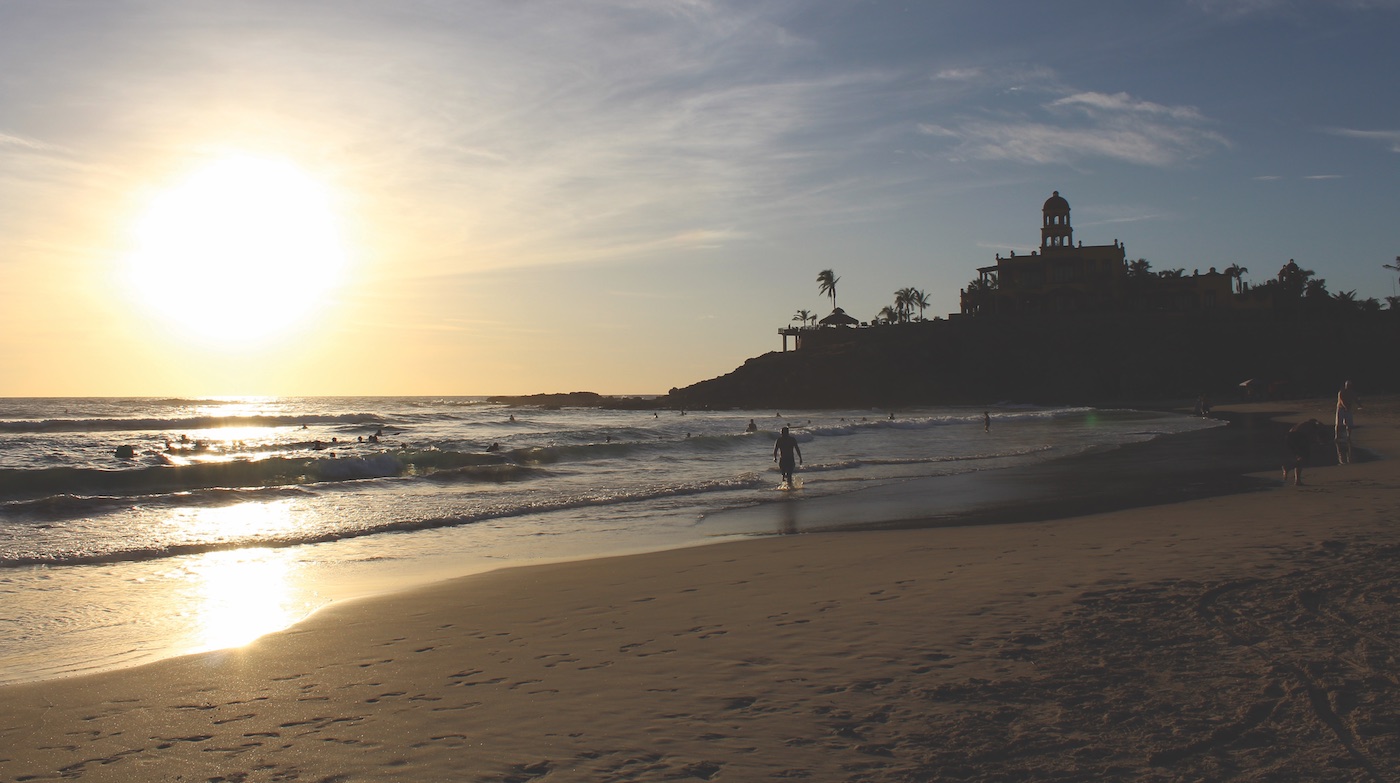by Justin Porter Biel
The landscape appears lost between past and present. To my left, there are dry, arid hillsides descending towards sandy coves along the Pacific. On the right, the skeleton of an unfinished home, the concrete foundation like bones missing organs and veins and skin. An expensive hotel sits in the distance upon the edge of a cliff, the structure imposing and grand, with yellow walls and red roofs, impossible to miss within the dusty terrain. Palm trees surround the palatial hacienda, and near the sea, black cliffs appear and recede, matching the temper of each incoming wave.
I’m taking in the view from atop a mule on a wooden saddle, riding up the coastal-hill that separates Cerritos from Pescadero. The stirrups are too short for my long, skinny legs, and a rash is developing on the inside of both knees. I reach into my pocket, grab my phone, and begin snapping photos of my friends – three gringos wearing cowboy hats and a young Mexican guide, all of us cloaked in early, soft morning light. We ride to the top of a hill, pause to take in the view, and then ride down the other side, heading north along the Pescadero coast.
It’s 10 AM, and the temperature is rising fast. Sweat drips down the small of my back, and the sturdy neck of the mule is drenched, wet hair clumped together. The animal feels tense, so I pat the mule’s neck trying to calm his nerves. He reacts with a flick of his head, shaking my hand away like a flea.
 At the bottom of the hill the horses are suddenly antsy; I assume they know that home is just ahead. Their muscular bodies surge forward, wanting to break into a gallop, chomping at the literal bit. The horses want water, shade, and hay, and to be free of our imposing weight.
At the bottom of the hill the horses are suddenly antsy; I assume they know that home is just ahead. Their muscular bodies surge forward, wanting to break into a gallop, chomping at the literal bit. The horses want water, shade, and hay, and to be free of our imposing weight.This section of coast is more populated than the last. Dozens of houses sit on the hillside, while others encroach upon the sand. The homes share certain traits – sea-facing windows, expansive decks and patios – but in size and architectural design, each is different and unique.
«None of this was here five years ago,» says Paul, the friend who’s invited us on today’s ride.
Our guide says nothing, just nods in agreement, his face suddenly contemplative; his eyes scanning the hillside, nose creased with wrinkles. The horse he’s riding is young, still in training, and now and again the animal pirouettes and kicks up dust all around us. It rears its head and flares its nostrils. Our guide takes a moment to calm the horse before leading us forward once again.
As we push on I observe the contrast, noticing the indelible fingerprints of man on the natural world. There are houses everywhere, not eyesores per se, but unnatural all the same. We pass by a home with a steel gate, twelve feet high, an assumed deterrent for would-be intruders. A yellow bird sits atop the entrance, watching us, our bodies jostling to the rhythm of each horse. I wave at a couple standing behind the gate and they wave back. Nearby a growling engine breaks the morning silence. When the noise get’s louder, we take the horses to the side of the road, allowing room for a white, paint-chipped truck to pass. A red, souped-up, four-person quad follows, zipping by at a faster rate. It has red lighting bolt paint, exposed shocks, and a motor that sounds like a chainsaw. I look back in search of the bird, but its nowhere to be found.
We are all here together – man, machine, and nature – sharing in the vast expanse of this peninsula, hoping to breathe in the unbridled ruggedness of it all.
I think people are drawn to the Baja for a reason. The land is nourishing, a place for both escape and renewal, and yet even with remoteness such as this, comes a bit of morning traffic. Words like progress, tradition, community, and inclusion appear, the definitions sparring within my mind. I think about these words and wonder if it’s possible – all of them existing together. I think about the land, and it’s people, rich, storied, and worthy of our respect. I think deeper, peeling back layers, while overlooking a mansion overlooking the Pacific.
It begs the question – who is in charge? Who determines the meaning of progression? Who, beneath all the progress, is actually in control? Who is holding the reins?
«Ah damn,» says Paul.
I catch sight of Paul’s cowboy hat as it flies from his head and lands behind us in the dust. «I got it,» says our guide, and rides back to retrieve it, galloping fast on the squirrely, adolescent steed. When he gets to the hat, he doesn’t dismount, nor even stop. Instead, he keeps the animal moving, swings his weight to one side and swooping down in a single motion, grabs the hat from the dirt. It’s a skillful move, but the shift in weight spooks the horse and the animal bolts and charges forward at top speed.
The horse is coming at us, his eyes filled with wild, blurred energy. The guide holds on; his body parallel to the ground, his left foot stuck in the stirrups. When he frees his foot, it’s dragging, and then he’s hopping on it, driving the sneaker into the dirt. He tries to slow the horse, but the animal’s filled with heaving breaths and driven by charging powerful legs. Out of options, he removes his right foot and slides off the other side, losing his grasp on the reins.
Uncontrolled, the horse screams forward, barreling toward a meeting of slack-jawed gringos, all of us idling in the road.
The next moment is a blur, the kind where time distorts, happening both in slow motion and somehow also at warp speed. Through heightened senses I feel everything at once; the rubbing of the saddle straps on my thigh; the density of the leather reins in my hand; a gasp of breath, warm and dry as it passes into my lungs; the pain in my back from the jarring wooden saddle.
The horse is coming.
A collision is imminent.
Finally, I know who’s in charge.
[/vc_column_text][/vc_column][/vc_row]]]>



